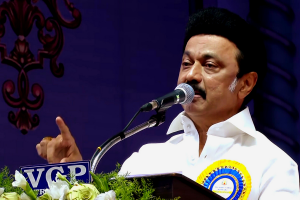I was surprised to learn that, according to an Oxford index tracking global student mobility, 69 per cent of Indian students who want to study abroad consider the US to be the most desirable destination. When I was a student in India no one thought about the USA for undergraduate education. Apart from tuition and living expenses, there were many cultural barriers, considered to be too severe to overcome at a tender age, not to mention the language (accent) difference. Applying for graduate studies to schools offering financial assistance was the way to go. I had always been satisfied with my undergraduate education in India. That satisfaction has now turned into pride and a feeling of being blessed.
I am thrilled by the recent trend whereby a series of first-generation Indian Americans with undergraduate education in India rose to topmost leadership roles in major high technology companies including Adobe System, Microsoft, IBM and Google/Alphabet. It is a testimonial to the soundness of undergraduate education in India. This strength was already known from professional accomplishments of Indian immigrants in medicine, economics, business and traditional science subjects. However, they reached the upper management echelons only after long experience in their careers.
Advertisement
The recent trend of rapid career advancements of Indians suggests other indirect benefits of Indian education. In my opinion, undergraduate education in India is on par with that in the US and even better in some respects. The curriculum in India consists of a specific set of subjects within a particular major area that each student must take. In the US, although there are a few mandatory “core courses”, they have a rather wide range of available courses to choose from to complete the degree requirements. I believe that it is important for young students in their late teens to undergo exposure to a variety of preselected topics instead of them selecting courses based more on curiosity or a fad or recommendations from someone.
This makes Indian college education more complete. Secondly, the system in India emphasizes reading textbooks and memorizing whereas the American educational philosophy is to encourage independent thinking and writing based on hands-on experience. The ability to memorize is not a bad skill. It is good to know all the key theories and their derivations by heart because it enhances a fundamental understanding of the logic involved. The US system emphasises problem solving whether one grasps the basic ideas or not. Students spend longer hours in classrooms in India typically five or even six days a week and five or six periods every day which run back-to-back with an hour-long break for lunch. It keeps them focused on their studies. The typical course load for an undergraduate student in USA is eighteen credit hours which translates into eighteen hours per week with plenty of idle time between classes.
There are more opportunities for extra-curricular activities in the US, especially in various sports. However, all these extra-curricular activities in American colleges provide distractions which often force the students to sacrifice their main goal. Some of these distractions can lead to rather dangerous and sometimes tragic consequences such as possible addictions to alcohol, drugs, gambling and sex. While it is important to have programmes geared to physical activities, the purpose of colleges should not be training students to become professional athletes by spending millions on various athletic programmes. If a student is truly exceptional in a particular sport, private organizations should seek them out and train them using private funds. Qualifications and the drive for corporate executive positions come from some contributing factors. First is the strong emphasis on mathematical skill in Indian education which is now enhanced by the availability of computers. At the same time, the educational system in the US has been suffering from a continuous decline in math teaching.
It started with “common core” philosophy in high school curricula, designed to bring social equity in the learning process. This strength in math is essential not only in STEM subjects but also in the financial sector (economics, accounting, tax), business management, real estate, consulting, international commerce, etc. Secondly, Indian students are more fluent in English compared to Asian, South American and Eastern European students. In addition to their fluency in English they are better at interpersonal interactions with others (including Amercians), perhaps a result of spending time daily with the same group of classmates. This strength has been increasing in recent decades, thanks to the major influx of Indian IT engineers, influence of social media and more recognition of Indian culture in general. There is another subtle but important reason.
College education in India opens one’s eyes to politics. Union elections, protests and political posters on the walls are all parts of college life in India. Coming from such an environment, absence of vigorous political discussions and debates on the campuses in this country surprised me. While ideological passion could be disruptive, I feel that American undergraduate students are shockingly naïve when it comes to the question of how they would like to see their country governed. Familiarity with politics might be giving Indian employees an edge in “climbing up the ladder”.
They know how to manage people, how to negotiate diplomatically and how to effectively campaign for a cause. Promotions to higher ranks do not simply fall in one’s lap. One must show a drive for it and actively lobby for it. Many in India wonder why India herself has not been able to develop such technology leaders with Indian students who did not come abroad. The reason is that one also needs postgraduate education to advance to higher ranks. The educational situation is reversed in graduate school. By its very definition a doctoral degree requires independent research and formulation of new ideas. Here the American universities are superior because of the availability of all kinds of modern scientific equipment, professional journals/ books in the library, opportunities to interact with various faculty members and fellow students, encouragement to attend conferences and present papers and so on. In addition, the sheer number of PhD-granting schools throughout the country is quite impressive. The Indian system is limited in most of these aspects. Even the professors themselves find it difficult to keep up with the latest developments on any given research topic, thus hindering their abilities to properly guide their doctoral students on an appropriate path. One can get the best of both worlds by having undergraduate education in India and doing graduate studies in the USA. This is true even for the children born and raised in America. College education in India would be financially attractive and will keep them away from undesirable external influences. I hope that universities in India actively advertise inexpensive undergraduate college education in India all over the world to see if they can attract international students, even ones from the USA.
Indian universities can especially emphasize their low-cost offerings in medical education (like medical schools in the Caribbean and Eastern Europe) and other areas like mathematics and IT related subjects. In conclusion, the undergraduate education system in India is an asset that the country can leverage in gaining various advantages. Increased income from tuition can fund improvements in both the quality of professors and infrastructure of the colleges. Enrolment of foreign students could lead to various avenues of foreign investment and cultural exchanges. I am thankful that I had the privilege of this learning experience.
(The writer, a physicist who worked in industry and academia, is a Bengali settled in America.)











